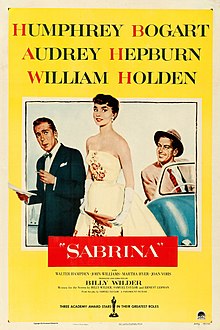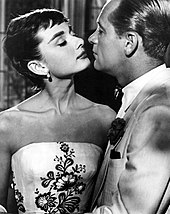Sabrina (1954 film)
| Sabrina | |
|---|---|
 Theatrical release poster | |
| Directed by | Billy Wilder |
| Screenplay by |
|
| Based on | Sabrina Fair by Samuel A. Taylor |
| Produced by | Billy Wilder |
| Starring | |
| Cinematography | Charles Lang |
| Edited by | Arthur P. Schmidt |
| Music by | Frederick Hollander |
| Distributed by | Paramount Pictures |
Release date |
|
Running time | 113 minutes[2] |
| Country | United States |
| Language | English |
| Budget | $2.2 million |
| Box office | $4 million (rentals)[3] |
Sabrina (Sabrina Fair/La Vie en Rose in the United Kingdom) is a 1954 American romantic comedy-drama film directed by Billy Wilder, adapted for the screen by Wilder, Samuel A. Taylor and Ernest Lehman from Taylor's 1953 play Sabrina Fair.[4] The picture stars Humphrey Bogart, Audrey Hepburn and William Holden. This was Wilder's last film released by Paramount Pictures, ending a 12-year business relationship between Wilder and the company. The film was selected for preservation in the United States National Film Registry by the Library of Congress in 2002.[5]
Plot[]

Sabrina Fairchild is the young daughter of the Larrabee family's chauffeur, Thomas, and has been in love with David Larrabee all her life. David is a three-times-married playboy who has never paid attention to Sabrina because to him she was still a child. Eavesdropping on a party at the Larrabee mansion, as she has often done before, Sabrina notices David enticing yet another woman. Distraught, she leaves her father a suicide note and starts every car in the garage so as to kill herself. Instead she is interrupted by David's older brother Linus, who escorts her back to her quarters above the garage.
Sabrina had been on the point of sailing for France, where she is to attend Le Cordon Bleu, the leading culinary school in Paris. After two years there, she returns home as an attractive and sophisticated woman. When her father is delayed from picking her up at the station, David offers her a lift instead without even knowing it is Sabrina.
Once David realizes who she is, he is quickly drawn to Sabrina and invites her to join him at a party at the mansion. When Linus sees this, he fears that David's imminent marriage to Elizabeth Tyson may be endangered. If the engagement is broken, it would ruin a profitable opportunity for a great corporate merger between Larrabee Industries and Elizabeth's very wealthy father's business. Instead of confronting David about his irresponsibility, Linus pretends to sympathize with him. In a moment of inattention, David sits down on champagne glasses he has placed in his pockets, so that he is incapacitated for a few days.
Linus now takes David's place with Sabrina on the pretext that “it’s all in the family” until both fall in love, although neither will admit it. In fact Linus’ plan is to pretend to be accompanying Sabrina back to Paris but not to join her on the liner. However, when he reveals his intention to Sabrina instead, she agrees to leave the next day and never come back.
The following morning, Linus has second thoughts and decides to send David to Paris with Sabrina. This means calling off David's wedding with Elizabeth and the big Tyson deal, and he schedules a meeting of the Larrabee board to announce this. David enters the room at the last minute and declares that he has decided to marry Elizabeth after all. David helps Linus recognize his own feelings for Sabrina and assists him in rushing off to join Sabrina's ship before it leaves the harbor. Linus and Sabrina meet on board and sail away together.
Cast[]


- Humphrey Bogart as Linus Larrabee
- Audrey Hepburn as Sabrina Fairchild
- William Holden as David Larrabee
- John Williams as Thomas Fairchild, Sabrina's father
- Walter Hampden as Oliver Larrabee, Linus and David's father
- Nella Walker as Maude Larrabee, Linus and David's mother
- Martha Hyer as Elizabeth Tyson, David's fiancée
- Marcel Dalio as Baron St. Fontanel
- Marcel Hillaire as The Professor, Sabrina's culinary instructor
- Ellen Corby as Miss McCardle, Linus' secretary
- Francis X. Bushman as Mr. Tyson, Elizabeth's father
- Joan Vohs as Gretchen Van Horn
- Nancy Kulp as Jenny, the maid (uncredited)
- Raymond Bailey as member of the board (uncredited)
- Emory Parnell as Charles - Butler (uncredited)
Production[]
Initially, Cary Grant was considered for the role of Linus, but he declined,[6] and the role was taken by Bogart. Best known for playing tough detectives and adventurers, Bogart was cast against type as a smart businessman gradually transformed into a romantic lead.
During production of the film, Hepburn and Holden entered into a brief but passionate and much-publicized love affair. Bogart had originally wanted his wife Lauren Bacall to be cast as Sabrina. He complained that Hepburn required too many takes to get her dialogue right and pointed out her inexperience.[7]
Bogart was very unhappy during the filming, convinced that he was totally wrong for this kind of film, mad at not being Wilder's first choice, and not liking Holden or Wilder. But Wilder's offbeat casting produced a performance that critics generally considered successful. Bogart later apologized to Wilder for his behavior on set, citing problems in his personal life.[citation needed]
Wilder began shooting before the script was finished, and Lehman was writing all day to complete it. Eventually he would finish a scene in the morning, deliver it during lunch, and filming of it would begin in the afternoon.[7]

Although Edith Head won an Oscar for Best Costumes, most of Hepburn's outfits are rumored to have been created by Hubert de Givenchy and chosen personally by the star. In a 1974 interview, Head stated that she was responsible for creating the dresses, with inspiration from some Givenchy designs that Hepburn liked, but that she made important changes, and the dresses were not by Givenchy.[8] After Head's death, Givenchy stated that Sabrina's iconic black cocktail dress was produced at Paramount under Head's supervision but claimed it was his design.[9]
The film began a lifelong association between Givenchy and Hepburn. It has been reported that when Hepburn called on Givenchy for the first time in Paris, he assumed that it was Katharine Hepburn in his salon.[10]
The location used to portray the Larrabee family's mansion in Glen Cove, New York was 'Hill Grove', the home of George Lewis in Beverly Hills, California.[11] This mansion was later demolished during the 1960s. The location used to portray the Glen Cove train station was the Glen Cove train station on the Oyster Bay Branch of the Long Island Rail Road.[11] The building at 30 Broad Street in Manhattan's financial district was used as the location for the headquarters of the Larrabee company.[11]
Reception[]
The film opened in New York and Los Angeles on September 23, 1954[1] and was number one at the US box office for two weeks.[12]
Awards and nominations[]
Remakes[]
There have been Indian adaptations of the film. Manapanthal (1961) was a Tamil version, followed in the same year by a Telugu version, Intiki Deepam Illale. In addition Sabrina was the inspiration for the successful Hindi film Yeh Dillagi (1994), although with some changes to the plot.[14] Then in 1995 there was the Hollywood remake from Paramount Pictures.
References[]
- ^ Jump up to: a b Sabrina at the American Film Institute Catalog
- ^ "SABRINA FAIR (U)". British Board of Film Classification. 1954-03-29. Retrieved 2012-12-09.
- ^ 'The Top Box-Office Hits of 1954'. Variety Weekly. January 5, 1955.
- ^ "Sabrina". Turner Classic Movies. Atlanta. Retrieved September 6, 2016.
- ^ "Films Selected for the National Film Registry in 2002 (January 2003) - Library of Congress Information Bulletin".
- ^ Jaynes, Barbara Grant; Trachtenberg, Robert. Cary Grant: A Class Apart. Burbank, California: Turner Classic Movies (TCM) and Turner Entertainment. 2004.
- ^ Jump up to: a b Ben Mankiewicz of Turner Classic Movies.
- ^ Dorléac, Jean-Pierre (2010-10-24). "Edith Head and the 'Sabrina' dress". Los Angeles Times.
- ^ "Style on Film: Sabrina". 20 March 2011.
- ^ "On This Day In Fashion".
- ^ Jump up to: a b c "Sabrina 1954 film locations". The Worldwide Guide To Movie Locations. Archived from the original on 2016-03-03. Retrieved February 20, 2016.
- ^ "National Boxoffice Survey". Variety. October 13, 1954. p. 3 – via Archive.org.
- ^ "NY Times: Sabrina". Movies & TV Dept. The New York Times. 2009. Archived from the original on 2009-04-02. Retrieved 2008-12-21.
- ^ Guy, Randor. "Manappandal". The Hindu. Retrieved 27 April 2014.
Further reading
- Shaw, Mark; Juliet Cuming; David Taylor (2009-04-14). Charmed by Audrey: Life on the Set of Sabrina. San Rafael, CA: Insight Editions. ISBN 978-1-933784-87-8. (Candid photographs of Audrey, on and off the set, taken by Mark Shaw for Life magazine during production of the film.)
- "Audrey Hepburn, Many-sided Charmer". Life. Vol. 35 no. 23. December 7, 1953. pp. 127–135. ISSN 0024-3019. (Life article on Hepburn including some of the photos from the Sabrina set.)
External links[]
| Wikiquote has quotations related to: Sabrina (1954 film) |
| Wikimedia Commons has media related to Sabrina. |
- 1954 films
- English-language films
- 1954 comedy-drama films
- 1954 romantic comedy films
- 1954 romantic drama films
- 1950s romantic comedy-drama films
- American black-and-white films
- American films
- American films based on plays
- American romantic comedy-drama films
- Films about social class
- Films directed by Billy Wilder
- Films set in country houses
- Films set in Long Island
- Films set in New York (state)
- Films set in Paris
- Films shot in Los Angeles
- Films shot in New York City
- Films that won the Best Costume Design Academy Award
- Films with screenplays by Billy Wilder
- Films with screenplays by Ernest Lehman
- Paramount Pictures films
- United States National Film Registry films